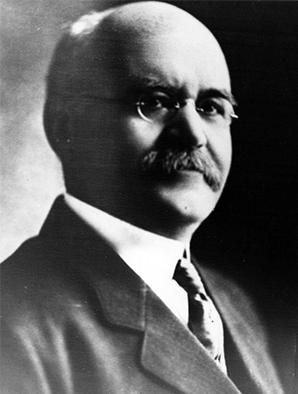Grove, Edwin Wiley
27 Dec. 1850–27 Jan. 1927
 Edwin Wiley Grove, proprietary drug manufacturer and Asheville developer, was born in Whiteville, Hardeman County, Tenn., the son of James Henry and Mary Jane Harris Grove. Both of his parents were natives of Virginia; as a Confederate soldier, his father served with General Nathan B. Forrest. After attending local schools, young Grove went to Memphis, just two counties west, to study pharmacy. In 1880 he established his own pharmacy in Paris, Tenn., where he had worked earlier as a clerk in a drugstore. At Paris he developed the formula for two products that were to make him a fortune. Grove's Tasteless Chill Tonic was sold widely, particularly in the South where quinine had long been used as an antimalarial drug. Grove's formula improved the unpleasant taste of the quinine. He also developed a product that he marketed as Grove's Bromo-Quinine tablets. Shortly, it was reported, his products were bringing him a million dollars a year. Grove expanded his manufacturing facilities from those originally established at Paris to St. Louis, Mo., and to England, Australia, Brazil, and Argentina. He also planned an extensive and pioneer advertising program.
Edwin Wiley Grove, proprietary drug manufacturer and Asheville developer, was born in Whiteville, Hardeman County, Tenn., the son of James Henry and Mary Jane Harris Grove. Both of his parents were natives of Virginia; as a Confederate soldier, his father served with General Nathan B. Forrest. After attending local schools, young Grove went to Memphis, just two counties west, to study pharmacy. In 1880 he established his own pharmacy in Paris, Tenn., where he had worked earlier as a clerk in a drugstore. At Paris he developed the formula for two products that were to make him a fortune. Grove's Tasteless Chill Tonic was sold widely, particularly in the South where quinine had long been used as an antimalarial drug. Grove's formula improved the unpleasant taste of the quinine. He also developed a product that he marketed as Grove's Bromo-Quinine tablets. Shortly, it was reported, his products were bringing him a million dollars a year. Grove expanded his manufacturing facilities from those originally established at Paris to St. Louis, Mo., and to England, Australia, Brazil, and Argentina. He also planned an extensive and pioneer advertising program.
Beginning in 1897 when he built a summer home there, Grove spent a great deal of time in Asheville, N.C., as he found the climate good for his health. In 1905 he took the first step of what became a large scale development of hotel, business, and residential property on the northern edge of the town. He began with the development of Grove Park, a residential area, and in 1912–13 constructed Grove Park Inn as a resort hotel on the west slope of Sunset Mountain. Built of massive stones, with a frontage of almost 500 feet, and rising in a series of terraces, it has long been regarded as one of the finest resort hotels in the world. Grove next purchased the old Battery Park Hotel, razed it, cut down the hill on which it had stood, and erected a new Battery Park Hotel. Opposite the entrance to the new hotel he constructed a mall of shops topped by offices. Earth from the hill was used to fill a large ravine, which formed a new commercial area for the growing city. East of Asheville he developed Grovemont residential area. In and around Asheville he also established and developed other areas and businesses. His interests were not centered in just this site, however, for he owned extensive property in St. Louis, Mo., St. Petersburg, Fla., Atlanta, Ga., and elsewhere.
Grove was generous and as nearly as possible kept his benefactions secret. Contributing to charitable, educational, and religious causes, he built and endowed a high school in Paris, Tenn., and endowed a number of Presbyterian churches, of which denomination he was an active member. His first wife, whom he married in 1875, was Mary Louisa Moore of Milan, Tenn. They were the parents of two daughters, Irma and Evelyn. The latter married Fred Loring Seely who was involved in the building of the Grove Park Inn. After the death of his wife, in 1883, Grove was married in 1886 to Alice Gertrude Matthewson of Murray, Ky. Their children were Hallett Hardin, Edwin Wiley, and Helen. Grove died in Asheville and after funeral services in the city's First Presbyterian Church, of which he was a member, he was buried in the family cemetery near his place of birth.
References:
Asheville Citizen, 28, 29 Jan. 1927, 8 May 1949.
National Cyclopaedia of American Biography, vol. 21 (1931).
Additional Resources:
Bailey, Heather L. "Edwin Wiley Grove (1850-1927)." The Tennessee Encyclopedia of History and Culture version 2.0. January 4, 2010. http://tennesseeencyclopedia.net/entry.php?rec=1606 (accessed July 15, 2013).
"Grove Park Inn." National Registry of Historic Places Travel Itinerary. National Park Service. https://www.nps.gov/nr/travel/asheville/gro.htm (accessed July 15, 2013).
Neufeld, Rob. "E. W. Grove & Grove Arcade." Grove Arcade. 2006. http://www.grovearcade.com/wp-content/uploads/2010/06/GA_BriefHistory.pdf (accessed July 15, 2013).
Waters, T. Wayne. "Asheville's Grove Park Inn celebrates centennial with special events." Knoxville News Sentinel. January 12, 2013. http://www.knoxnews.com/news/2013/jan/12/ashevilles-grove-park-inn-celebrates-centennial/ (accessed July 15, 2013).
Image Credits:
"File:Edwin Wiley Grove.jpg." Photograph. Wikimedia Commons. http://commons.wikimedia.org/wiki/File:Edwin_Wiley_Grove.jpg (accessed July 15, 2013).
1 January 1986 | Powell, William S.